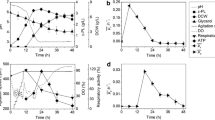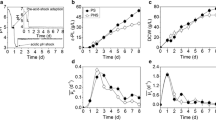Abstract
Candicidin is one of the most effective antimonilial agents. In order to enhance candicidin productivity, medium optimization and pH stepwise control strategy in process optimization were conducted by Streptomyces ZYJ-6. With the aid of Design Expert software and N/C/P-sources regulation, chemically defined medium fit for cell growth and candicidin biosynthesis was developed. Moreover, pH effects on cell growth and metabolism were investigated. The results indicated that the optimal pH for cell growth and candicidin biosynthesis were 6.8 and 7.8, respectively. The metabolomics analysis revealed that the pH stepwise control strategy (pH 6.8–7.8) combined the advantages of pH 6.8 and pH 7.8 and avoided precursor limitation in pH 6.8 and 7.8. Consequently, the pH stepwise control strategy played positive performance on cell growth and candicidin biosynthesis with the maximum titer of 5161 µg/mL. The titer of 5161 µg/mL was the highest level ever reported for candicidin production, which laid a solid foundation for industrial application. Additionally, pH stepwise control strategy was important reference for process optimization.






Similar content being viewed by others
References
Waksman SA, Lechevalier HA, Schaffner CP (1965) Candicidin and other polyenic antifungal antibiotics: a review*. Bull World Health Org 33(2):219–226
Mao XZ, Wang F, Zhang JG, Chen S, Deng ZX, Shen YL, Wei DZ (2009) The pH shift and precursor feeding strategy in a low-toxicity FR-008/candicidin derivative CS103 fermentation bioprocess by a mutant of Streptomyces sp. FR-008. Appl Biochem Biotech 159(3):673–686
Lechevalier H, Acker RF, Corke CT, Haenseler CM, Waksman SA (1953) Candicidin, a new antifungal antibiotic. Mycologia 45:155–171
Chen S, Huang X, Zhou XF, Bai LQ, He J, Jeong KJ, Lee SY, Deng ZX (2003) Organizational and mutational analysis of a complete FR-008/candicidin gene cluster encoding a structurally related polyene complex. Chem Biol 10(11):1065–1076
Liang RF, Zhou Q (1987) Studies on fusion breeding of protoplasta from antibiotic producing strain 5120-III genetic analysis of fusion products. Chin J Biotechnol 3(2):130–136
Zhou YJ, Li JL, Zhu J, Chen S, Bai LQ, Zhou XF, Wu HM, Deng ZX (2008) Incomplete beta-ketone processing as a mechanism for polyene structural variation in the FR-008/candicidin complex. Chem Biol 15(6):629–638
Acker RF, Lechevalier H (1954) Some nutritional requirements of Streptomyces griseus 3570 for growth and candicidin production. Appl Microbiol 2(3):152–157
Liu Q, Xiao L, Zhou Y, Deng K, Tan G, Han Y, Liu X, Deng Z, Liu T (2016) Development of Streptomyces sp. FR-008 as an emerging chassis*. Synth Syst Biotechnol 1(3):207–214
Zhu BF, Xu Y (2010) Production of tetramethylpyrazine by batch culture of Bacillus subtilis with optimal pH control strategy. J Ind Microbiol Biot 37(8):815–821
Li X, Lin Y, Chang M, Jin Q, Wang X (2015) Efficient production of arachidonic acid by Mortierella alpina through integrating fed-batch culture with a two-stage pH control strategy. Bioresour Technol 181(Supplement C):275–282
Liu C-M, McDaniel L, Schaffner C (1975) Factors affecting the production of candicidin. Antimicrob Agents Ch 7(2):196–202
Martin JF, McDaniel LE (1975) Kinetics of biosynthesis of polyene macrolide antibiotics in batch cultures: cell maturation time. Biotechnol Bioeng 17(6):925–938
Gil JA, Naharro G, Villanueva JR, Martín JF (1985) Characterization and regulation of p-aminobenzoic acid synthase from Streptomyces griseus. J Gen Microbiol 131(6):1279–1287
Fei R, Long C, Xiong S, Tong Q (2017) Enhanced acarbose production by Streptomyces M37 using a two-stage fermentation strategy. Plos One 12(2):1–11
Jiang J, Sun YF, Tang X, He CN, Shao YL, Tang YJ, Zhou WW (2018) Alkaline pH shock enhanced production of validamycin A in fermentation of Streptomyces hygroscopicus. Bioresour Technol 249(Supplement C):234–240
Ochi K (1987) Metabolic initiation of differentiation and secondary metabolism by Streptomyces griseus: significance of the stringent response (ppGpp) and GTP content in relation to A factor. J Bacteriol 169(8):3608–3616
Plackett RL, Burman JP (1946) The design of optimum multifactorial experiments. Biometrika 33(4):305–325
Chen X, Tang L, Li S, Liao L, Zhang J, Mao Z (2011) Optimization of medium for enhancement of ε-Poly-l-lysine production by Streptomyces sp. M-Z18 with glycerol as carbon source. Bioresource Technol 102(2):1727–1732
Mao XZ, Shen YL, Wei DZ, Chen S, Deng ZX (2005) Determination of Candicidin/FR-008 and related components in fermentation broth by RP-HPLC. J Chin Pharm Sci 14(2):115–118
de Jonge LP, Buijs NA, ten Pierick A, Deshmukh A, Zhao Z, Kiel JA, Heijnen JJ, van Gulik WM (2011) Scale-down of penicillin production in Penicillium chrysogenum. Biotechnol J 6(8):944–958
Cipollina C, ten Pierick A, Canelas AB, Seifar RM, van Maris AJA, van Dam JC, Heijnen JJ (2009) A comprehensive method for the quantification of the non-oxidative pentose phosphate pathway intermediates in Saccharomyces cerevisiae by GC-IDMS. J Chromatogr B 877(27):3231–3236
Hong M, Mou H, Liu X, Huang M, Chu J (2017) 13C-assisted metabolomics analysis reveals the positive correlation between specific erythromycin production rate and intracellular propionyl-CoA pool size in Saccharopolyspora erythraea. Bioproc Biosyst Eng 40:1337–1348
Zou X, Li WJ, Zeng W, Chu J, Zhuang YP, Zhang SL (2011) An assessment of seed quality on erythromycin production by recombinant Saccharopolyspora erythraea strain. Bioresour Technol 102(3):3360–3365
Liras P, Villanueva JR, Martín JF (1977) Sequential expression of macromolecule biosynthesis and candicidin formation in Streptomyces griseus. J Gen Microbiol 102(2):269–277
Martin JF, Demain AL (1976) Control by phosphate of candicidin production. Biochem Bioph Res Co 71(4):1103–1109
Wang T, Bai LQ, Zhu DQ, Lei X, Liu G, Deng ZX, You DL (2012) Enhancing macrolide production in Streptomyces by coexpressing three heterologous genes. Enzyme Microb Tech 50(1):5–9
Dias C, Sousa S, Caldeira J, Reis A, Lopes da Silva T (2015) New dual-stage pH control fed-batch cultivation strategy for the improvement of lipids and carotenoids production by the red yeast Rhodosporidium toruloides NCYC 921. Bioresour Technol 189(Supplement C):309–318
Tang L, Zhang YX, Hutchinson CR (1994) Amino acid catabolism and antibiotic synthesis: valine is a source of precursors for macrolide biosynthesis in Streptomyces ambofaciens and Streptomyces fradiae. J Bacteriol 176(19):6107–6119
Acknowledgements
We thank Prof. Dr. Delin You (Shanghai Jiao Tong University) for supplying Streptomyces ZYJ-6. This work was financially supported by a grant from the Major State Basic Research Development Program of China (973 Program, no. 2012CB721000G), NWO-MoST Joint Program (2013DFG32630) and national key special Program 2017YFF 0204600.
Author information
Authors and Affiliations
Corresponding author
Ethics declarations
Conflict of interest
The authors declare that they have no conflict of interest.
Electronic supplementary material
Below is the link to the electronic supplementary material.
Rights and permissions
About this article
Cite this article
Liu, X., Sun, X., Wang, T. et al. Enhancing candicidin biosynthesis by medium optimization and pH stepwise control strategy with process metabolomics analysis of Streptomyces ZYJ-6. Bioprocess Biosyst Eng 41, 1743–1755 (2018). https://doi.org/10.1007/s00449-018-1997-x
Received:
Accepted:
Published:
Issue Date:
DOI: https://doi.org/10.1007/s00449-018-1997-x




